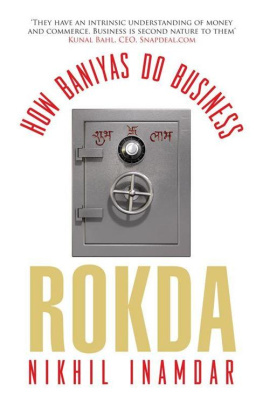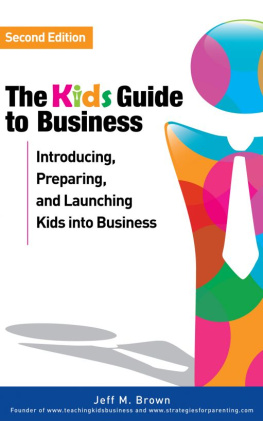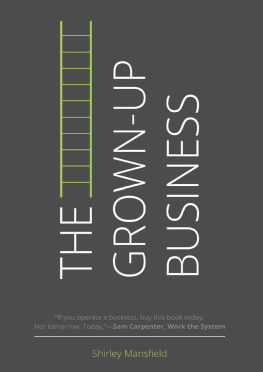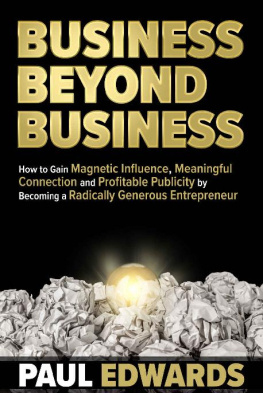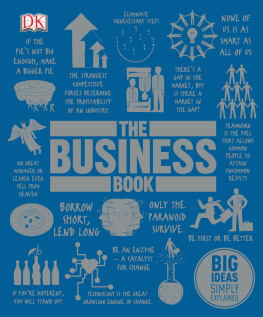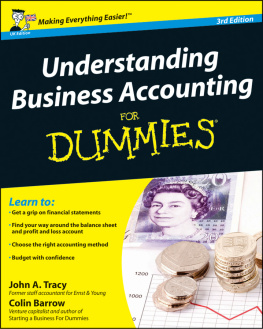Inamdar - Rokda: how Baniyas do business
Here you can read online Inamdar - Rokda: how Baniyas do business full text of the book (entire story) in english for free. Download pdf and epub, get meaning, cover and reviews about this ebook. City: India, year: 2014, publisher: Random House India, genre: Home and family. Description of the work, (preface) as well as reviews are available. Best literature library LitArk.com created for fans of good reading and offers a wide selection of genres:
Romance novel
Science fiction
Adventure
Detective
Science
History
Home and family
Prose
Art
Politics
Computer
Non-fiction
Religion
Business
Children
Humor
Choose a favorite category and find really read worthwhile books. Enjoy immersion in the world of imagination, feel the emotions of the characters or learn something new for yourself, make an fascinating discovery.
- Book:Rokda: how Baniyas do business
- Author:
- Publisher:Random House India
- Genre:
- Year:2014
- City:India
- Rating:4 / 5
- Favourites:Add to favourites
- Your mark:
- 80
- 1
- 2
- 3
- 4
- 5
Rokda: how Baniyas do business: summary, description and annotation
We offer to read an annotation, description, summary or preface (depends on what the author of the book "Rokda: how Baniyas do business" wrote himself). If you haven't found the necessary information about the book — write in the comments, we will try to find it.
Rokda: how Baniyas do business — read online for free the complete book (whole text) full work
Below is the text of the book, divided by pages. System saving the place of the last page read, allows you to conveniently read the book "Rokda: how Baniyas do business" online for free, without having to search again every time where you left off. Put a bookmark, and you can go to the page where you finished reading at any time.
Font size:
Interval:
Bookmark:

RANDOM HOUSE INDIA

Nikhil Inamdar is a Mumbai based financial journalist and currently consulting columnist at Business Standard Online. He was a prime time news presenter for NDTV Profit and worked for several years as a television correspondent at reputed news channels after completing a postgraduate degree in broadcast journalism from the UK. This is his first book.
For my big, fat, thriving, shining Indian household
The Baniya is a loosely used expression in India, employed interchangeably to refer to the corner shop kiranawallah, the calculating money lender or the quintessential Marwari businessman next door. The connotation is often negative, but the etymology of the word is found in the Sanskrit term, vnij, which simply means trader or merchant. Originating primarily in the northern and western parts of India, the Baniyas have historically been engaged in professions ranging from money lending, commodities trading, stock broking, and shop keeping. In the present day however, they straddle sectors of the modern economy as varied as internet enabled retail, mobile telephony, and oil and gas exploration.
They are a separate Indian caste with specific sub-castesMaheshwaris, Agarwalas etc, religious affiliations Hindu and Jain, distinctive social customs, also have typical surnames on the basis of the clan to which they belong Bansal, Mittal, Singhal, Goel, Garg and so on. In a wider context, the term Baniya is also used in parts of the country to refer to a conglomeration of people from diverse geographical and religious backgrounds, engaged broadly in commerce.
When I was approached to do this book that would feature the growth stories of five Baniya entrepreneurs, the first thought that crossed my mind was whether entrepreneurship could be dissected from the prism of caste alone. Could I possibly use old social segregations and hierarchies as a basis to pick a group of entrepreneurs and tell their stories? Wouldnt that only restate community stereotypes that may or may not hold true any longer?
As I began approaching people I was interested in featuring in the book, one young whiz kidwhose online restaurant-discovery portal had just received millions of dollars in private equity fundingbanged the phone down on me asking never to call again. Baniyas in business?! Why would you want to categorize me in that manner? he almost shrieked, evidently annoyed at my appeal to let his new-age success story be identified by the caste to which he was born.
If for a moment that incident made me circumspect about this project, all my doubts subsided once I began the interviews. For every person that was dismissive of the role their community may have played in influencing the choices they made in life, I met five others who reiterated the conscious and imperceptible weight that caste-based idiosyncrasies had on their psyche. That is not to say that those featured in this book are solely or even primarily defined by their Baniya identity. Far from it actually! After all modernity and the global nature of enterprise will have blunted old typecasts and altered our DNA considerably, wouldnt it?
But to fully discount the peculiarities of a clan established by generations of cultural and organizational frameworks would be arrogant and ill-conceived. Which is why, uncovering through these case studies why the Baniyas in particular could have long held hegemony on Indian enterprise, and continue to remain such a dominating force in the orb of commerce and trade was an exciting endeavor. From their stomach for risk and high trust culture to the strong joint family and community support infrastructure that could enable their initial rise, from their amazing ability to adapt and adjust well in unfamiliar environments to their penchant for keeping a close tab on costs and spend conscientiously; there are more positive stereotypes about the Baniyas that hold true than dont.
They have an intrinsic understanding of money and commerce. Business is second nature to them reckons Kunal Bahl of Snapdeal.com. He is surrounded by Baniyasfrom his own partner Rohit, to all his competitors that inhabit Indias e-commerce landscape. But, it is what Rohit Bansal himself shared with me that strikes a deeper chord. The community he says is inherently comfortable with uncertainty, and remains undaunted by the constant oscillations in their financial circumstances. What a virtue that is for a good businessman to have!
The five stories in this bookof the men behind Emami, Snapdeal, Meru Cabs, Hindware, and Bansal Classesseek to bring out the matchless ingenuity of this community, and demonstrate through them how the Baniya has evolved with times, whilst continuing to retain his own unique cultural identity. I attempt to do this without necessarily keeping the caste factor at the fore, but with hope that the spirit of the Baniya DNA, which is wired for enterprise, will shine through in the narrative time and again.
The companies Ive chosen not only represent different sectors of the Indian economy, but also the changing landscape of doing business in India. Emami and Hindware are brands that have withstood the test of time, blossomed in the face of cataclysmic changes. Meru Cabs and Snapdeal symbolize the spectacular opportunity liberalization has afforded to entrepreneurship and Bansal Classes is a tale of triumph in adversity.
July 16, 2014
C irca 2006It was a regular day at work. Neeraj Gupta was in a meeting at his sprawling, newly acquired office in Goregaon when the dreaded call first came.
Come out and take a look hollered that familiar intimidating voice on the other side of the line. Gupta skipped a heartbeat and rushed out, dashing down the stairs to the garage below, praying to the lord to give him strength to face what was about to greet him.
The scene he witnessed still flashes like a strobe in his memory. Broken windows, cracked windshields, and splintered glass on the floorthe brand new garage below the office, where he parked his fleet of taxis, had been rummaged through by one of the biggest names in Mumbai underworld. Gun shots had been fired, property had been damaged, a business for which Gupta had given his sweat and blood was being seized up literally. His life was in grave danger.
The first set of calls had started a year earlier. On the morning of 26 July 2005 to be precisethe fateful day that ravaged Mumbai as torrential rains inundated the city, causing large-scale destruction of life and property. Curiously, just the night before, four of Neerajs vehicles had met with fatal accidents all at once, forcing him to spend the entire night at Lilavati Hospital in Bandra, attending to his staff.
One of the drivers has died, a shaken Neeraj remembers telling wife Farhat on the phone, perplexed at how four vehicles from his staff transportation business were involved in mishaps on one single night. She asked him to come home early, sounding anxious. He did, but only the next morningweary and fatigued. And just as he was about to crash into bed the cell phone rang.
Dubai se baat kar raha hoon, someone said in Hindi. It wasnt a voice Gupta recognized, but the tone was telling enough. Thankfully, the minute he uttered Dubai, Gupta had the presence of mind to start recording the conversation.
Font size:
Interval:
Bookmark:
Similar books «Rokda: how Baniyas do business»
Look at similar books to Rokda: how Baniyas do business. We have selected literature similar in name and meaning in the hope of providing readers with more options to find new, interesting, not yet read works.
Discussion, reviews of the book Rokda: how Baniyas do business and just readers' own opinions. Leave your comments, write what you think about the work, its meaning or the main characters. Specify what exactly you liked and what you didn't like, and why you think so.

